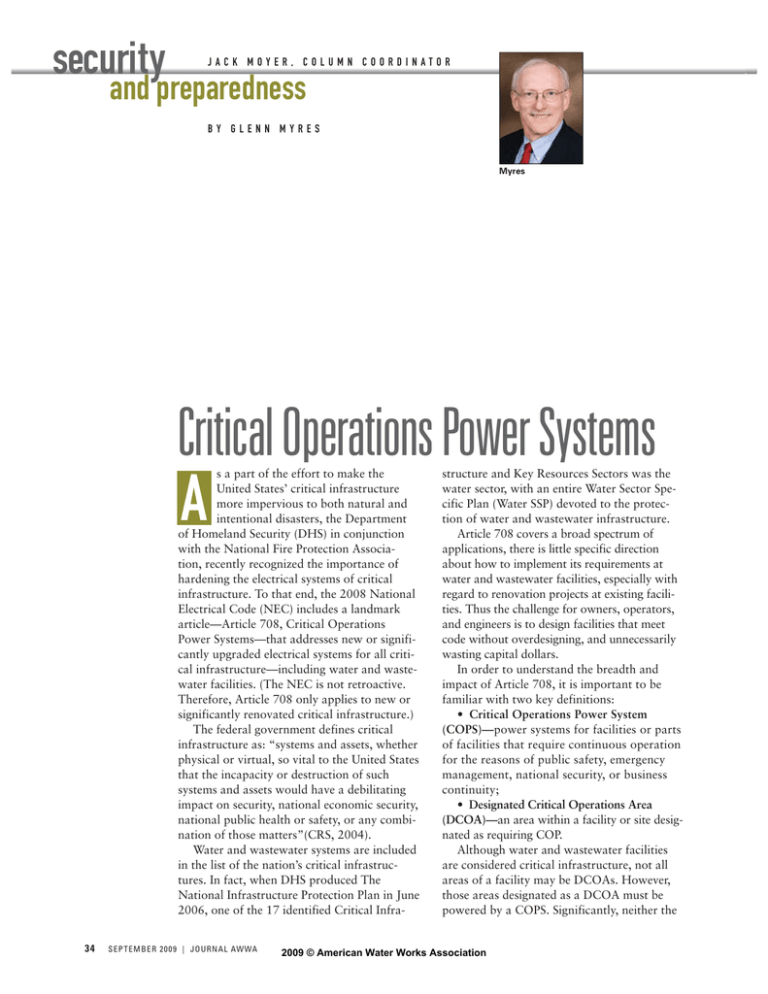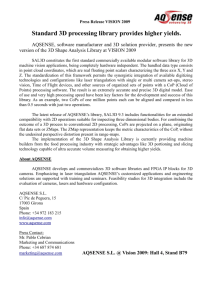Critical Operations Power Systems
advertisement

security JACK MOYER, COLUMN COORDINATOR and preparedness BY GLENN MYRES Myres Critical Operations Power Systems A s a part of the effort to make the United States’ critical infrastructure more impervious to both natural and intentional disasters, the Department of Homeland Security (DHS) in conjunction with the National Fire Protection Association, recently recognized the importance of hardening the electrical systems of critical infrastructure. To that end, the 2008 National Electrical Code (NEC) includes a landmark article—Article 708, Critical Operations Power Systems—that addresses new or significantly upgraded electrical systems for all critical infrastructure—including water and wastewater facilities. (The NEC is not retroactive. Therefore, Article 708 only applies to new or significantly renovated critical infrastructure.) The federal government defines critical infrastructure as: “systems and assets, whether physical or virtual, so vital to the United States that the incapacity or destruction of such systems and assets would have a debilitating impact on security, national economic security, national public health or safety, or any combination of those matters”(CRS, 2004). Water and wastewater systems are included in the list of the nation’s critical infrastructures. In fact, when DHS produced The National Infrastructure Protection Plan in June 2006, one of the 17 identified Critical Infra- 34 SEPTEMBER 2009 | JOURNAL AWWA structure and Key Resources Sectors was the water sector, with an entire Water Sector Specific Plan (Water SSP) devoted to the protection of water and wastewater infrastructure. Article 708 covers a broad spectrum of applications, there is little specific direction about how to implement its requirements at water and wastewater facilities, especially with regard to renovation projects at existing facilities. Thus the challenge for owners, operators, and engineers is to design facilities that meet code without overdesigning, and unnecessarily wasting capital dollars. In order to understand the breadth and impact of Article 708, it is important to be familiar with two key definitions: • Critical Operations Power System (COPS)—power systems for facilities or parts of facilities that require continuous operation for the reasons of public safety, emergency management, national security, or business continuity; • Designated Critical Operations Area (DCOA)—an area within a facility or site designated as requiring COP. Although water and wastewater facilities are considered critical infrastructure, not all areas of a facility may be DCOAs. However, those areas designated as a DCOA must be powered by a COPS. Significantly, neither the 2009 © American Water Works Association security and preparedness Water SSP nor Article 708 specifies which systems or areas of a facility should be designated as a DCOA. This determination is left up to the owner/operator (DHS, 2007). Once a facility or a portion of a facility is classified as a DCOA, Article 708 sets forth specific requirements the facility must meet. (1) A risk assessment must be performed on each DCOA, and mitigation strategies must be developed to address defined risks. The Water SSP (section 3) contains guidance to perform this risk assessment. (2) Locations that house COPS electrical feeder distribution equipment (substations, motor control centers, panelboards) must be 2-hour fire-rated and must be above the 100-year flood plain. Thus if new COPS electrical distribution equipment is installed at an existing facility, the fire rating of the location of the new electrical equipment may have to be upgraded. (3) Access to COPS equipment must be limited to qualified personnel only. A “qualified person” is defined in NEC Article 100 as: “One who has skills and knowledge related to the construction and operation of the electrical equipment and installations and has received safety training to recognize and avoid the hazards involved.” This may require that COPS electrical equipment be housed in separate rooms, whereas historically, electrical equipment has often been located on the process floor. Additionally, operators who have had ready access to (and frequently operate) motor control centers, switchboards, circuit-breaker panel boards, and other electrical equipment may have to receive additional training to meet this requirement. (4) COPS and non-COPS systems must be kept physically separate, including separate transfer switches and separate conduit systems. If it is determined that parts of the water or wastewater treatment facility are critical (whereas others are not), separate electrical systems must be installed for COPS, and non-COPS, starting from the utility service all the way to the loads. (5) A second onsite source of power for the DCOAs must be capable of operating the DCOAs for three days (72 hours). Article 708 lists four acceptable onsite power sources: • storage batteries, • a generator set, • an uninterruptible supply of power, or • a fuel cell system. A second utility source is not included as an acceptable alternative. For most water and wastewater facilities, a generator is the only practical alternative. Therefore, in most cases, onsite power generation will be required rather than simply relying on two electrical utility sources as has been acceptable in the past. (6) Article 708 requires an onsite fuel supply. Where a generator is used as the second electrical source, the unit cannot use natural gas as its only fuel source. Dual fuel (diesel/natural gas) is acceptable; however duel-fuel units are frequently more costly. For planning purposes, it is useful to know that 72 hours of fuel for a 1,500-kW diesel generator is approximately 7,600 gal. (7) The wiring of COPS systems must be physically protected. With some minor exceptions, wiring must be installed in metal conduit or in concrete-encased nonmetallic conduit. (8) COPS electrical feeders must be a minimum of 1-hour fire-rated, or embedded in a minimum of 2 2009 © American Water Works Association in. of concrete. Because normal building wire is not fire-rated, Type MI (mineral insulated) or other fire-rated cable or cable assembly is required unless the conduits can be concrete-encased. (9) COPS electrical feeders must be separate from non-COPS wiring. This may require additional conduit systems to separate nonCOPS wiring. (10) Control, monitoring, and power wiring for HVAC systems must be 2-hour fire-resistive cable or a listed 2-hour electrical circuit protective system. (11) Only fiber optic cables can be used for HVAC, fire alarm, security, and emergency communications and signaling systems between buildings. The NEC has also gone further than ever before in requiring initial and ongoing testing and record keeping. A few of the newly required items include the following: • A Commissioning Testing Plan must be developed to not only demonstrate that the COPS operates properly under maximum anticipated loads, but that the testing results also establish the baseline for all future testing results. Article 708 requires that the authority having jurisdiction (AHJ)—usually the electrical inspector—witness the initial baseline testing. • The COPS system must be tested periodically while being witnessed by the AHJ. • A documented preventive maintenance program must be developed, and maintenance records must be kept. When does Article 708 apply? If the 2008 NEC is in effect in the specific jurisdiction when design plans and specifications are submitted for the building permit, then Article 708 applies. Interested parJOURNAL AWWA | SEPTEMBER 2009 35 security and preparedness permit can be issued and the facility can pass inspection. As an example, the inspector may forgo the requirement for the aeration system generator if a plan is submitted to install a standby generation system for the entire facility within a certain number of years. Although Article 708 is still being fine-tuned, changes will certainly be made in future revisions of the National Electrical Code. For now, utilities, design engineers, and contractors should all be aware of these new requirements because they could affect nearly every new water or wastewater facility project that falls under the 2008 NEC. ties can go to www.nema.org/stds/ fieldreps/NECadoption/implement. cfm to determine whether the 2008 NEC is in effect in a specific location and, if not, when it is anticipated to be adopted. It may be challenging to sort out how to implement the requirements of Article 708 when a facility undergoes a partial upgrade. For instance, if an aeration system is being upgraded at a wastewater treatment plant and the upstream and downstream processes do not have a backup generator, it makes little sense to install one on the aeration system alone. In this case an acceptable agreement may need to be worked out so that the building —Glenn Myres is an electrical engineer with Malcolm Pirnie and is responsible’s for the company’s Central US electrical engineering design. He has more than 40 years’ experience, more than 11 of which are in water and wastewater engineering. Myres can be contacted at gmyres@ pirnie.com or (614) 430-2656. REFERENCES CRS (Congressional Research Service), 2004. Critical Infrastructure and Key Assets: Definition and Identification. Library of Congress, Washington. DHS (Department of Homeland Security), 2007. Water Sector-Specific Plan as Input to the National Infrastructure Protection Plan. DHS, Washington. Water professionals around the world know that WQTC is the event of the year for providing answers about Quality Water in a High-Tech Environment! WATER QUALITY TECHNOLOGY CONFERENCE® & EXPOSITION The premier conference for water quality professionals around the world November 15–19, 2009 Washington State Convention & Trade Center Seattle, Washington TAKE ADVANTAGE OF THESE OUTSTANDING OPPORTUNITIES X 60 TECHNICAL SESSIONS X 350 PRESENTATIONS X 500 EXPERTS IN WATER QUALITY X 44 PAPERS WITH INTERNATIONAL PERSPECTIVE X 12 SPECIAL–TOPIC SESSIONS X AND MUCH MORE Visit www.awwa.org/conferences/wqtc for more information and to register today! The Authoritative Resource on Safe Water ® 36 SEPTEMBER 2009 | JOURNAL AWWA 2009 © American Water Works Association

